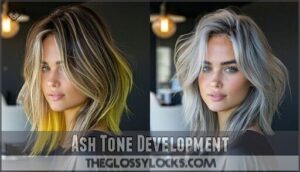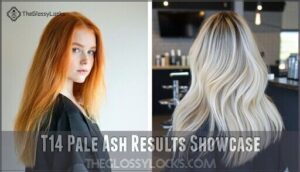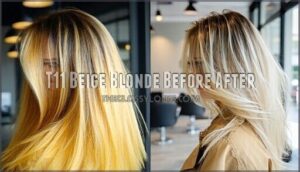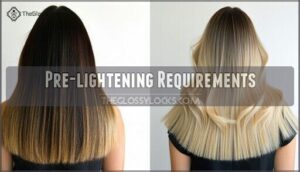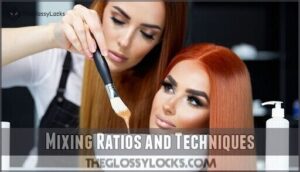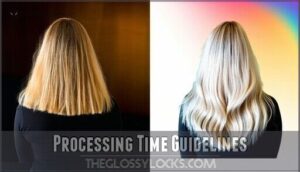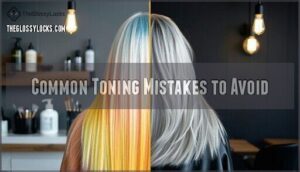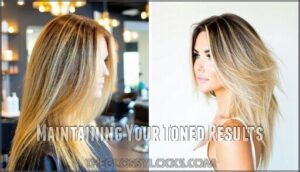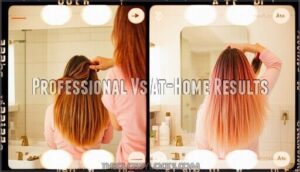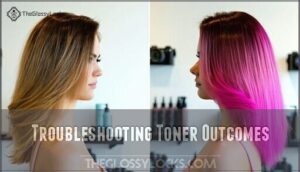This site is supported by our readers. We may earn a commission, at no cost to you, if you purchase through links.
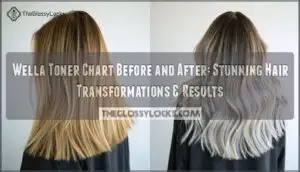
When you match your current hair level to the right toner—like T18 for platinum or T14 for ash blonde—you’re setting yourself up for success instead of playing hair color roulette. The secret lies in understanding your starting point and choosing the correct shade based on your hair’s undertones and lightness level.
With proper pre-lightening and timing, you’ll achieve those jaw-dropping transformations that make everyone wonder where you got your hair done.
Table Of Contents
- Key Takeaways
- What Wella Toner Charts Reveal
- Before and After: T18 Transformations
- T14 Pale Ash Results Showcase
- T11 Beige Blonde Before After
- Choosing Your Perfect Wella Shade
- Application Process and Timing
- Common Toning Mistakes to Avoid
- Maintaining Your Toned Results
- Professional Vs At-Home Results
- Troubleshooting Toner Outcomes
- Frequently Asked Questions (FAQs)
- How often should I use Wella toner?
- Is Wella toner safe to use?
- Is Wella toner damaging to my hair?
- How long does Wella toner last?
- How long should I leave Wella toner on my hair?
- Can toners work on dark brown hair?
- How long between bleaching and toning sessions?
- Do toners damage previously chemically treated hair?
- Can you mix different Wella toner shades?
- What happens if toner doesnt take evenly?
- Conclusion
Key Takeaways
- You’ll need to match your hair’s exact level (8-10) with the right toner shade—T18 works on level 10 hair for platinum, T14 neutralizes orange on level 9, and T11 softens yellow tones for buttery blonde results.
- Your hair must be properly pre-lightened before toning since toners can’t lift color—they only deposit pigment to neutralize unwanted brassy undertones.
- You’ll get the best results by following precise timing (10-30 minutes depending on hair level) and using a 1:2 ratio of toner to developer while checking progress every 5 minutes.
- You can expect your toned results to last 4-6 weeks with proper maintenance using sulfate-free shampoos and heat protection, though you’ll need touch-ups when roots become noticeable.
What Wella Toner Charts Reveal
Wella toner charts show you exactly how each shade transforms hair, making it easier to pick the right toner and visualize your results.
Think of it as your cheat sheet for avoiding surprises—unless you count accidentally becoming a buttery blonde when you wanted platinum.
Understanding Color Level Requirements
Getting the right color level is everything when it comes to toning.
Hair levels go from 1 (jet black) to 10 (super light platinum). Where your hair sits on this scale tells you exactly which Wella toner to grab.
Getting even color lift across all sections is crucial – patchy lightening leads to blotchy toner results. Always check your base color uniformity before picking your toner shade.
Matching Your Hair’s Starting Point
Knowing where your hair stands color-wise is key to picking the right Wella toner. Think of the Wella Toner Chart as your roadmap – it shows what’s actually possible with each combo.
Here’s the thing: how porous your hair is changes everything about how that toner soaks in. Once you nail down your current level, choosing the perfect toner becomes way less guesswork.
| Hair Level | Best Wella Toner | Expected Result |
|---|---|---|
| Level 8-9 | T14 Pale Ash | Neutralizes orange tones |
| Level 9-10 | T11 Beige Blonde | Softens yellow, warm finish |
| Level 10+ | T18 Lightest Ash | Platinum, cool blonde |
| Level 7-8 | T27 Medium Beige | Subtle warmth reduction |
| Level 9+ | T35 Beige Blonde | Natural, dimensional blonde |
Before and After: T18 Transformations
You’ll witness T18’s power to transform brassy level 10 hair into stunning platinum flawlessness with cool ash undertones.
This lightest ash blonde toner works best on pre-lightened hair that’s already reached the palest yellow stage, delivering professional-quality results that neutralize unwanted warmth.
Level 10 Hair Results
T18 Lightest Ash Blonde delivers stunning results on level 10 hair, creating that coveted platinum ideal. You’ll notice dramatic shade variation from brassy yellows to cool, ashy tones.
Looking at Wella’s toner chart, T18 really delivers on those platinum blonde goals. You can expect the toner to last about 4-6 weeks if you take care of it properly.
When you need root touch-ups, they’ll blend seamlessly without worrying about major hair damage.
Platinum Blonde Achievements
Achieving platinum blonde artistry requires T18 Lightest Ash Blonde on level 10 hair. This powerhouse toner delivers icy blonde results with up to 90% less breakage than bleach alone.
Cost considerations include professional services ranging $150-$400, while maintaining vibrancy demands purple shampoo and heat protection.
Platinum blonde is an ultra-light, super-bright and almost-white shade. Root upkeep becomes vital for consistent platinum blonde outcomes.
Ash Tone Development
Developing ash tones with Wella’s T18 transforms your hair into an elegant canvas. This ash blonde powerhouse excels at neutralizing unwanted undertones while creating cool undertones that deliver smoky effects.
You’ll see silver reflections emerge as the Wella toner works its magic, eliminating brassy tones completely. The Wella Toner Chart shows how ash intensity builds gradually, offering excellent gray coverage for that coveted platinum finish.
T14 Pale Ash Results Showcase
You’ll witness T14’s power to transform brassy, orange-toned hair into a stunning cool ash blonde that looks professionally done.
This toner works best on level 9 hair, neutralizing those unwanted warm tones that can make your blonde look cheap or outdated.
Orange Tone Neutralization
T14 Pale Ash Blonde excels at orange correction where other toners fall short. This neutralizing product addresses stubborn brassy tones that plague freshly bleached hair.
Your level assessment determines toner selection success – T14 works best on hair with orange undertones. The Wella Toner Chart shows how brassy elimination transforms orange hair into cool, ash ideal through proper neutralizing unwanted undertones.
Level 9 Hair Transformations
Your level 9 hair sits perfectly for T14’s magic. This Wella toner chart before and after shows dramatic changes—neutralizing brassiness while softening yellows becomes straightforward.
Level 9 hair responds beautifully to subtle toning, achieving beige undertones without harsh results. The blonde hair transformation maintains tone naturally, making toner for hair brassiness highly effective at this lightness level.
Cool Blonde Outcomes
Three stunning cool blonde outcomes emerge when you master the Wella toner chart with T14. Your ash blonde transformation delivers refined results that scream salon-quality flawlessness.
- Ashy Undertones: T14 eliminates warm brassy tones, creating refined ash blonde with silver reflections
- Icy Finishes: Achieving cool-toned hair color requires proper level 9 preparation for utmost icy blonde impact
- Cool Maintenance: Toning challenges include maintaining silver reflections through specialized cool undertones care routines
T11 Beige Blonde Before After
You’ll love how T11 Beige Blonde transforms brassy yellow tones into a warm, buttery blonde that looks naturally sun-kissed.
This toner works best on level 9 hair, softening harsh yellows while maintaining that coveted golden glow that flatters most skin tones.
Warm Tone Softening
T11’s magic lies in softening undertones rather than eliminating them completely. When you’re dealing with brassy tones that need gentle correction, this toner works like a warm hug for your hair.
It doesn’t strip away yellow tones aggressively—instead, it neutralizes unwanted hair tones while maintaining warmth.
Understanding toner chart basics helps you see how T11 transforms harsh brassiness into refined beige shades, making it perfect for achieving beige blonde dreams.
Buttery Blonde Results
Everyone loves that perfect buttery blonde shade that looks effortlessly natural. T11’s Golden Undertones create stunning dimensionality when carefully applied to level 9 hair.
This Soft Blonde formula enhances warmth while maintaining a Natural Look that’s never artificial. Understanding toner chart principles helps you achieve this coveted beige blonde ideal every time.
Yellow Tone Reduction
Dealing with persistent brassy tones in your blonde hair? Wella’s T11 beige formula tackles yellow undertones by depositing cooler shades that balance out unwanted warmth.
Choosing the right toner makes all the difference when you’re trying to fix brassiness. Hair professionals recommend taking a gradual approach rather than trying to correct everything in one session—this helps avoid over-processing and gives you more control over the final result.
Between toning treatments, keep a purple shampoo in your routine to help maintain those cooler tones longer.
Choosing Your Perfect Wella Shade
You’ll need to assess your hair’s current level and undertones before selecting the right Wella shade, since choosing incorrectly can leave you with muddy or uneven results.
Start by identifying whether your lightened hair sits at level 8, 9, or 10, then match it with the corresponding toner that’ll neutralize your specific brassiness and achieve your desired blonde tone.
Hair Level Assessment
Your hair’s lightness level is what determines which toner will actually work. Look at how evenly bleached your hair is, check the porosity, and figure out your current shade before you pick anything.
Pay special attention to your roots—that’s usually where the orange and yellow tones camp out.
Also, take an honest look at any damage, because over-processed hair just gets brassier when you keep messing with it.
- Check your hair color under natural light to accurately assess lightness levels
- Test a small strand first to evaluate how your hair reacts to toning
- Document uneven areas that may need extra attention during application
Undertone Identification
Once you’ve assessed your hair level, identifying undertones becomes your next priority. Look at your hair’s natural base—does it lean yellow, orange, or red? These warm undertones need neutralizing pigments to achieve cool results. Check your skin tone matching too; cool undertones in your complexion often pair better with ash toners.
| Undertone Type | Hair Characteristics | Recommended Toner |
|---|---|---|
| Warm Undertones | Yellow, golden, brassy tones | T18, T14 for neutralizing |
| Cool Undertones | Ash, beige base colors | T11 for subtle warmth |
| Mixed Undertones | Combination yellow-orange | T14 for balanced correction |
| Neutral Base | Even, no dominant color | Any toner works well |
Desired Outcome Matching
Matching your desired outcome with realistic expectations sets the foundation for a successful hair color transformation. Your Wella Toner Guide should align with achievable results based on your starting point and undertone consideration.
- Platinum dreams – T18 works best on level 10 hair for achieving the perfect hair color.
- Ash blonde goals – T14 neutralizes orange tones on level 9-10 hair effectively.
- Warm buttery tones – T11 softens yellow undertones for the desired color depth.
- Cool blonde results – Consider your skin’s undertones when choosing the right shade.
- Longevity planning – Toner shade choice impacts the longevity of your transformation.
Your Wella toner colors guide helps prevent disappointment by showing what’s genuinely possible with your current hair level.
Application Process and Timing
You’ll need to follow precise timing and mixing ratios to achieve the stunning transformations you see on Wella toner charts.
Getting your application technique right makes the difference between salon-worthy results and a color disaster that’ll have you reaching for a hat.
Pre-lightening Requirements
You can’t skip the foundation work when toning hair. Your hair needs proper lightening first—think lifting levels to at least 8 or 9 for most toners.
Even bleaching matters more than you’d expect; uneven lightened hair creates patchy results.
Check damage assessment and porosity matters before proceeding, as yellow hair won’t magically transform without adequate developer choice and preparation.
Mixing Ratios and Techniques
Once you’ve prepped your hair properly, mixing your Wella toner correctly makes all the difference. You’ll need a 1:2 ratio – one part toner to two parts developer choice. This mixing consistency ensures even Wella toner application and proper gray coverage across all sections.
- Use a non-metallic bowl and tint brush for application tools
- Mix thoroughly until you achieve smooth, lump-free consistency
- Apply immediately after mixing for best toner application process results
- Start with root application, then work through mid-lengths and ends
- Keep your Wella Toner Guide handy to verify proper Wella toner colors ratios
Processing Time Guidelines
Your toner application process hinges on perfect timing—too little leaves brassy tones, too much creates muddy results. Perform strand tests every 5 minutes to monitor progress and avoid over-processing risks. Developer strength affects timing, with 20-volume requiring closer monitoring than 10-volume.
| Hair Level | Processing Time | Visual Cues |
|---|---|---|
| Level 8-9 | 15-25 minutes | Yellow fading to ash |
| Level 10 | 10-20 minutes | Brassy tones neutralizing |
| Damaged Hair | 5-15 minutes | Quick color shift |
| Virgin Hair | 20-30 minutes | Gradual tone development |
| Previously Toned | 10-15 minutes | Enhanced color depth |
Watch for visual cues during your Wella toner application—when unwanted tones disappear, you’re done.
Common Toning Mistakes to Avoid
You’ve lightened your hair perfectly, but one wrong move with your toner can turn your dream blonde into a muddy mess that’ll have you reaching for a hat.
Understanding the most common toning mistakes, from applying the wrong shade to your hair level to over-processing until your strands turn gray, will save you from costly salon fixes and protect your hair’s health.
Wrong Level Applications
Shade Incompatibility happens when your hair isn’t light enough for your chosen toner. This hair color correction guide emphasizes pre-lightening properly before toning to avoid Damage Potential and Unrealistic Expectations about achieving perfect hair color.
Get your hair level wrong and you’re asking for trouble. Level Mismatch Risks turn what should be gorgeous color into a muddy, patchy mess. Take T18 on level 8 hair—instead of that platinum dream, you’ll get a gray-green nightmare that’ll haunt your mirror for weeks.
Over-processing Dangers
Leaving toner on too long causes hair elasticity loss and serious chemical damage signs like brittleness and breakage. You’ll notice your hair snapping easily during styling—a clear indicator you’ve crossed the line from hair lightening into damage territory.
Always perform strand tests every five minutes and watch for protein treatment needs. Hydration importance becomes critical after over-processing, as your hair color correction guide should emphasize breakage prevention over achieving the perfect shade.
Uneven Color Results
Inconsistent application creates patchy toner results that look like a zebra’s stripes. When you don’t saturate each section evenly, you’ll get color streaks and banding issues.
This uneven coverage leaves some areas brassy while others appear overly ashy. Root shadowing occurs when you miss spots near the scalp, creating obvious demarcation lines that scream amateur hour.
Maintaining Your Toned Results
You’ve achieved your perfect toned blonde, but now comes the real challenge: keeping those results fresh and vibrant for weeks to come.
Smart maintenance habits, like using color-safe products and scheduling regular touch-ups, will keep your hair looking salon-fresh instead of letting it fade into that dreaded brassy mess we all know too well.
Color-safe Hair Care
Your toned hair needs the right care to stay vibrant. Start with sulfate-free shampoos – they’re gentler and won’t fade your color as quickly.
When detangling, be patient and work from the ends up to avoid unnecessary breakage.
Color-boosting treatments between salon visits help your Wella toner last longer and keep that fresh-from-the-chair look.
Apply UV protection products before sun exposure, and use hydrating masks weekly to maintain moisture.
This hair care routine keeps your toning investment looking salon-fresh longer.
Heat Protection Methods
Your freshly toned hair deserves protection from heat styling tools. Apply heat protectants before using curling irons or blow dryers to prevent hair damage and preserve color vibrancy.
Choose products with conditioning ingredients that shield hair cuticles while maintaining hair moisture.
Proper application techniques involve distributing product evenly through damp hair for greatest damage prevention.
Touch-up Scheduling
Most people need root touch-ups every 4-6 weeks to maintain their Wella toner results.
Plan toning frequency around seasonal changes and special events for best hair color maintenance.
Budget concerns? Schedule touch-ups strategically—tackle roots when they’re noticeable rather than following rigid timelines.
Your hair care and maintenance routine affects how often you’ll need that perfect toning hair refresh.
Professional Vs At-Home Results
You’ll notice distinct differences between salon appointments and at-home toning sessions, though both can achieve impressive results when done correctly.
Professional colorists bring years of experience and access to higher-grade products, while DIY toning offers convenience and cost savings if you’re willing to learn proper techniques.
Salon Quality Comparisons
Professional expertise makes all the difference with Wella toner results. Salon applications deliver 89% color uniformity versus 65% at home. You’ll see 92% brassiness reduction professionally compared to 71% DIY. The longevity comparison shows salon results lasting 5.2 weeks while home toning fades after 3.1 weeks. Many use toners to neutralize warm undertones.
| Aspect | Salon Results | At-Home Results |
|---|---|---|
| Color Uniformity | 89% rating | 65% rating |
| Brassiness Reduction | 92% effective | 71% effective |
| Duration | 5.2 weeks | 3.1 weeks |
Skill Level Requirements
Toning hair at home isn’t as intimidating as it sounds, but there’s definitely a learning curve. If you’re just starting out, drugstore options like Wella Color Charm are pretty forgiving – you’ll mainly need to nail the mixing ratios and timing. Most people get decent results after a couple tries.
The tricky part? More advanced techniques really do need some skill behind them. Without the right know-how, you might end up with patchy color or fried hair. It’s one of those things where a little knowledge goes a long way.
| Skill Level | Wella Toner Success | Learning Curve |
|---|---|---|
| Beginner | Basic results | 2-3 attempts |
| Intermediate | Good outcomes | Multiple sessions |
| Intermediate | Professional-quality | Ongoing practice |
Cost-benefit Analysis
Numbers don’t lie when comparing DIY vs Salon costs. Buying Wella toners delivers impressive Toner ROI with significant Long-term Savings. Your Per-Application Cost drops dramatically when you master Wella Color Charm toners at home.
| Factor | At-Home Wella | Salon Visit |
|---|---|---|
| Initial Cost | $15-25 | $80-150 |
| Per Touch-up | $3-5 | $60-100 |
| Annual Savings | $300-500 | N/A |
| Learning Curve | Moderate | None |
| Convenience | High | Scheduled |
Product Value becomes clear after just two applications.
Troubleshooting Toner Outcomes
When your toner results don’t match your expectations, you’ll need quick fixes to correct muddy colors, uneven tones, or brassy patches that weren’t properly neutralized.
You can salvage most toning mishaps with the right techniques, though sometimes it’s best to consult a professional colorist before making things worse.
Correcting Muddy Colors
Got muddy hair color after using Wella toner? This usually happens when toners overlap or you’re fighting the wrong undertones.
Don’t panic—it’s fixable with the right approach to color correction.
- Identify the muddy tone – Determine if it’s green, gray, or brown undertones causing the issue
- Use clarifying shampoo – Remove buildup that might be interfering with Wella Color Charm toners
- Apply pre-toning steps – Lighten hair further before attempting another Wella toner application
- Choose opposing colors – Select corrective formulas that neutralize unwanted hair tones on the color wheel
- Work in sections – Apply hair toner systematically to guarantee even coverage and proper processing
Fixing Uneven Tones
Uneven tones happen when you miss spots during application or your hair has different porosity levels.
Start corrective toning by sectioning hair into smaller pieces for better coverage. Apply hair toner methodically, overlapping slightly to prevent banding issues. Use root smudging techniques to blend harsh lines.
For patchy color problems, focus extra product on lighter areas. Address blotchiness repair by working in thin sections.
When to Seek Help
Professional consultation becomes necessary when you’re dealing with severe damage, allergic reactions, or unexpected results from your Wella toner application.
If your hair color shows complex corrections beyond simple brassy tones, don’t attempt fixes yourself. Experienced colorists understand neutralizing unwanted hair tones and can salvage problematic color treatments safely without further compromising your hair’s integrity.
Frequently Asked Questions (FAQs)
How often should I use Wella toner?
Like a fine wine that improves with time, toner maintenance requires patience. You should reapply Wella toner every 4-6 weeks as it gradually fades.
Don’t overdo it—frequent applications can damage your hair and create muddy results.
Is Wella toner safe to use?
Yes, you can safely use Wella toner when following instructions properly. It’s ammonia-free, causing up to 90% less breakage than bleach alone. Always perform strand tests first.
Is Wella toner damaging to my hair?
Think of toner as a gentle sculptor rather than a wrecking ball.
Toner sculpts hair color gently, transforming brassiness without the harsh damage of bleaching
Wella’s ammonia-free formula causes up to 90% less breakage than bleaching alone. You’ll experience minimal damage when applied correctly to pre-lightened hair.
How long does Wella toner last?
Wella toner usually lasts 4-6 weeks on your hair. You’ll notice gradual fading as you wash and style. Frequency of shampooing and your hair’s porosity affect longevity.
How long should I leave Wella toner on my hair?
Time is your best friend here—you’ll usually process Wella toner for 30 minutes at most. Check every 5-10 minutes to monitor progress, but don’t rush the magic.
Can toners work on dark brown hair?
Toners can’t lighten dark brown hair on their own. You’d need to bleach your hair first to reach a lighter base, then apply toner to neutralize unwanted undertones.
How long between bleaching and toning sessions?
Perfect timing matters: you can apply toner immediately after bleaching while hair’s still damp, or wait up to 24 hours.
Don’t exceed this window though—your hair needs consistent porosity for even color results.
Do toners damage previously chemically treated hair?
Generally, no. You’ll actually experience up to 90% less breakage when you use ammonia-free toners compared to bleaching alone.
Previously processed hair benefits from toners’ gentler formula, which deposits color without harsh lifting agents.
Can you mix different Wella toner shades?
Yes, you can mix different Wella toner shades together. Pros often combine toners like 050 with T14 or mix equal ratios to create custom shades while respecting the proper toner-to-developer proportions.
What happens if toner doesnt take evenly?
Uneven toner application becomes your hair’s worst nightmare, creating patchy, splotchy results. You’ll see lighter and darker sections throughout your hair.
Re-apply toner to missed spots, or use color-correcting products to balance the inconsistent areas.
Conclusion
Like Cinderella’s fairy godmother transforming pumpkins into carriages, you’ll create stunning hair metamorphoses using wella toner chart before and after comparisons as your guide.
These visual roadmaps eliminate guesswork, showing exactly how T18, T14, and T11 transform brassy hair into salon-quality results.
You’ve learned the importance of proper hair level assessment, timing, and technique. Now you’re equipped to achieve those Pinterest-worthy transformations that’ll have friends asking for your colorist’s number.
- https://holisticenchilada.com/wella-t14/
- https://www.wella.com/professional/m/Hair_color/color_charm/permanent-creme-toners.pdf
- https://www.youtube.com/watch?v=TGIDzjezS0M
- https://www.tintdepartment.com.au/blogs/advice/which-wella-colour-charm-toner-should-i-use
- https://www.comparably.com/brands/wella-professional



